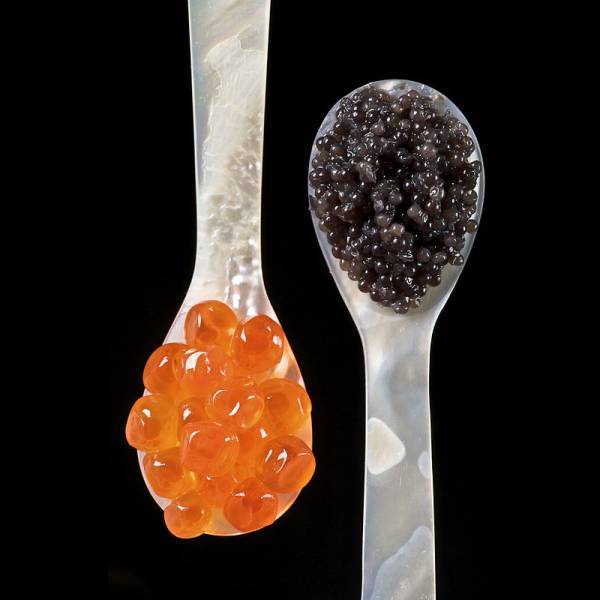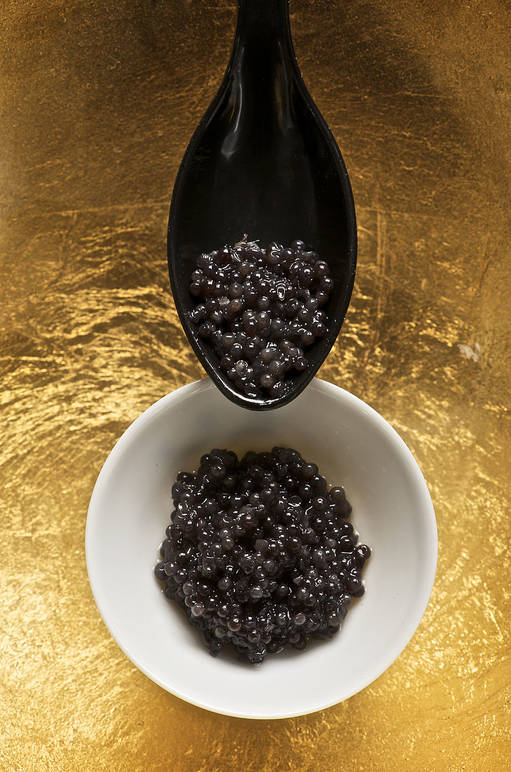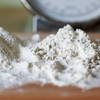Food Industry’s Black Gold
The sturgeon: a mysterious sh, a prehistoric giant – similar to the shark with a long snout and a line of pronounced ridges along its spine and sides. It takes at least 12 years for the female sturgeon to be ready to produce the small dark pearls that appear on our tables as caviar. After the killing, the eggs are separated through a delicate massage carried out with a sieve; they are then divided according to size and salted.
The salting can take place through an immersion in brine or by using dry salt, in which case the Master Salter personally executes the very delicate art of salting by hand. This is how you make caviar – a word of Turkish origin (“hayvar”) that was already present in recipe books belonging to the courts of the Italian Renaissance.
A little history (and politics)
Up until a few decades ago, both the Po and other large Western European rivers permitted a small local production of caviar, but the shing of the sturgeon and the conservation of its eggs has a strong tradition amongst the Cossacks of Ural and Volga.
From the 18th century, Caviar became a delicacy of the court and aristocracy of Moscow and St Petersburg, when the Cossacks began to give the Tsar the rst caviar harvest of the year in spring. In the 19th century, Russian aristocrats spread the fashion to Paris, making it “à la page” amongst the bourgeoisie who until then had only been curious about this particular delicacy.
In 1953, the Soviet Union, heir to the Tsarist monopoly on the production of caviar, gave Iran their shmongers who operated on the Persian shores of the Caspian Sea – the largest lake in the world. Since then both Russian and Iranian caviar has appeared on world markets, while before that point the caviar trade was an exclusively Russian monopoly.
Following this, the personal pilot of the Shah – an American named Finsun who enjoyed special attention from the Royal Family – managed to obtain exclusive rights to Iranian caviar and even exported the famous eggs to America. At the end of the 70s, however, following the Islamic Revolution and the boycott by US authorities, the relationship of exclusivity with America broke down in favor of Europe and Japan.
Europeans began to notice the difference in quality between Russian and Iranian caviar, with a particular appreciation for Garabrun caviar (also known as “Asetra Royal”) produced by the Acipenser Persicus sturgeon. Although Russian caviar is still today the most commercialized, it is both softer and stickier due to the use of an already mature egg. Iranian caviar, on the other hand, is more valuable and remains crunchy with consistent and well-de ned grains, that are in fact not spherical but dodecahedral.
Italy: the biggest producer in the world
Today, because of overshing, a large part of the 26 species of sturgeon are considered endangered, and their capture has been regulated since 1988. But caviar can be produced in a sustainable way through farming.
In Italy, at the end of the 1970s, the idea of farming sturgeons came about. Members of a
steel mill saw the possibility of using the waters for the cooling of steel, and then with a heat exchanger transferring the surplus heat from the steel- making process to the pure spring waters of Calvisano in the Canove area, near Brescia. This move would create an environment suitable for the farming of certain sh species.
The idea of farming the white Paci c sturgeon came as a result of the meeting of Gino Ravegnan, a longtime member and today the honorary president of Agroittica Lombarda, with Professor Serge Doroshov, a marine biologist at the University of California--Davis. Now the company produces and farms the biggest variety of caviar in the world. Throughout the 90s the Calvisius Tradition was born, known more commonly as the “black gold of Calvisano”; caviar made with innovative aquaculture techniques through the farming of sturgeons.
Today the production of caviar – from white, red, Siberian and Adriatic sturgeons – amounts to 25 tons a year, meaning Italy is the biggest producer of caviar in the world, covering 30% of the world’s production alone. Two tons are sold in Italy the rest is exported to Russia (who would have thought!), France, the United States, Germany, England and the United Arab Emirates.







































i-Italy
Facebook
Google+
This work may not be reproduced, in whole or in part, without prior written permission.
Questo lavoro non può essere riprodotto, in tutto o in parte, senza permesso scritto.